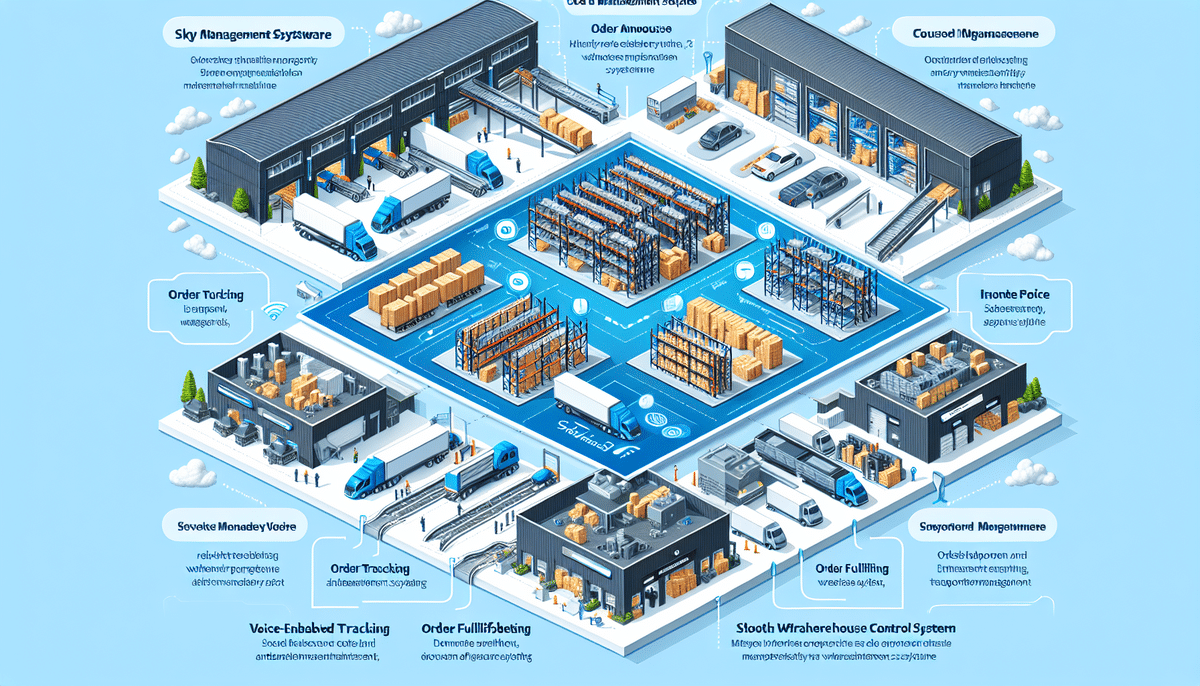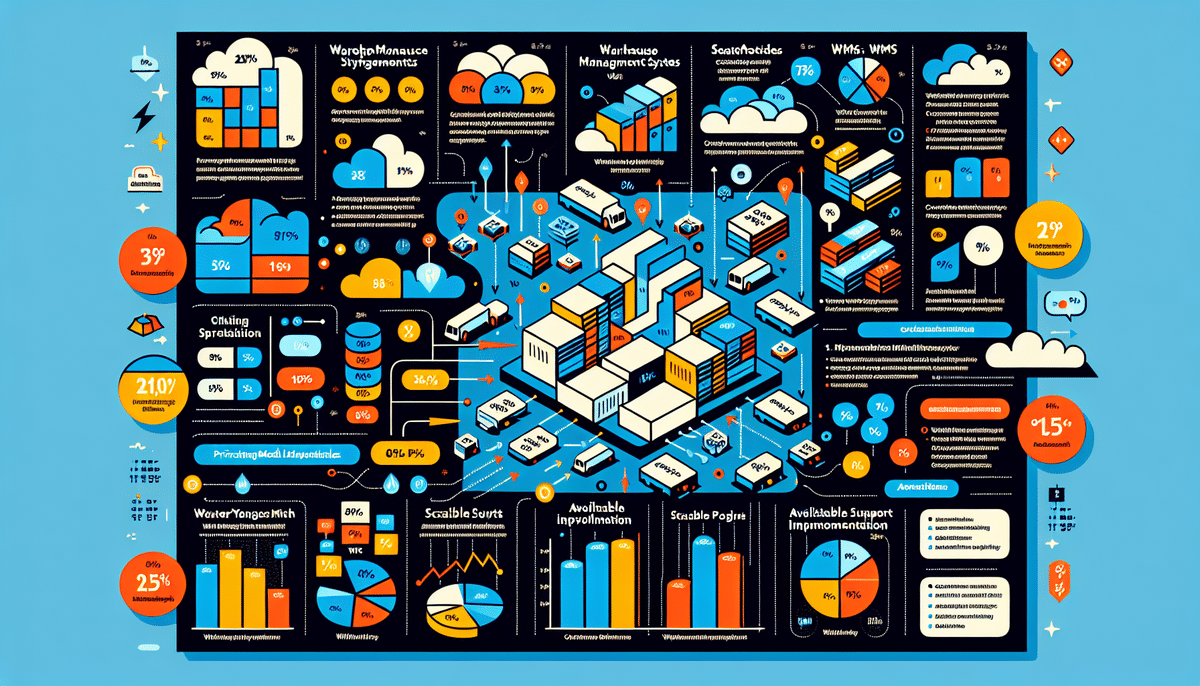Introduction to Warehouse Management Systems (WMS)
Warehouse Management Systems (WMS) are essential software solutions that enable businesses to automate and optimize their warehouse operations. These systems provide real-time inventory tracking and visibility, facilitate inventory receiving and shipping, streamline order fulfillment, and offer numerous other features that enhance efficiency and productivity. In today's competitive marketplace, selecting the right WMS can significantly impact your business's performance, and two of the leading options in the market are Blue Yonder (formerly JDA Software) WMS and Infor CloudSuite WMS.
The Importance of Choosing the Right Warehouse Management System
Selecting the appropriate Warehouse Management System (WMS) is a critical decision for any business that relies on efficient warehouse operations. A suitable WMS can enhance the accuracy of inventory tracking, improve the efficiency of warehouse processes, and ultimately increase profitability. The right WMS must align with your unique business requirements, offer the necessary functionalities to streamline your warehouse management processes, and integrate seamlessly with your existing systems.
According to a report by Gartner, businesses that implement an effective WMS can see a 10-15% improvement in warehouse efficiency and a 20-30% reduction in inventory carrying costs. Thus, investing in the right WMS is not just about improving operational workflows but also about achieving significant cost savings and enhancing customer satisfaction.
Blue Yonder WMS: Features and Benefits
Key Features of Blue Yonder WMS
Blue Yonder's WMS is a cloud-based solution renowned for its comprehensive feature set tailored to meet the needs of modern warehouses. Key features include:
- Real-Time Inventory Tracking: Blue Yonder offers near-perfect inventory accuracy with real-time tracking capabilities, ensuring that businesses have up-to-date information on stock levels and locations.
- Advanced Space Utilization: The system utilizes sophisticated algorithms to maximize warehouse space, reducing storage costs and improving layout efficiency.
- Labor Management: Blue Yonder provides tools for effective labor management, allowing businesses to optimize workforce allocation and increase productivity.
- Multi-Channel and Omni-Channel Support: The WMS supports complex distribution models, including multi-channel and omni-channel sales, enabling seamless inventory management across various sales channels.
- Real-Time Reporting and Analytics: Comprehensive reporting tools offer valuable insights into warehouse performance, aiding data-driven decision-making.
Benefits of Blue Yonder WMS
Implementing Blue Yonder's WMS offers numerous benefits for businesses, including:
- Scalability: Blue Yonder's WMS can accommodate businesses of all sizes, from small startups to large enterprises, ensuring that the system grows with your business needs.
- User-Friendly Interface: The intuitive design facilitates easy navigation, reducing the learning curve for employees and minimizing the need for extensive training.
- Enhanced Efficiency: Automation of inventory tracking and order fulfillment reduces errors and increases operational efficiency, leading to faster and more reliable delivery times.
- Data-Driven Insights: Real-time analytics enable businesses to identify areas for improvement and optimize warehouse operations based on actionable data.
Infor CloudSuite WMS: Features and Benefits
Key Features of Infor CloudSuite WMS
Infor CloudSuite WMS is a robust, cloud-based solution designed to enhance warehouse operations through innovative features, such as:
- Voice-Directed Warehousing: This technology allows warehouse workers to use voice commands for tasks like picking, packing, and inventory tracking, thereby reducing errors and increasing productivity.
- Advanced Warehouse Control System: Infor's WCS automates and optimizes various warehouse tasks, including inventory receiving, shipping, and order fulfillment, ensuring smooth operations.
- Inventory Optimization: The system offers tools for precise inventory management, reducing excess stock and ensuring optimal inventory levels.
- Real-Time Visibility: Infor CloudSuite WMS provides comprehensive real-time visibility into warehouse operations, facilitating better decision-making and responsiveness.
- Integration Capabilities: The WMS seamlessly integrates with other enterprise systems like ERP and transportation management systems, ensuring cohesive operations across the supply chain.
Benefits of Infor CloudSuite WMS
Businesses leveraging Infor CloudSuite WMS can experience several advantages, including:
- Increased Accuracy: Voice-directed warehousing minimizes human error, ensuring that orders are fulfilled correctly and efficiently.
- Enhanced Productivity: Automation of routine tasks allows warehouse workers to focus on more strategic activities, boosting overall productivity.
- Scalability and Flexibility: Infor's WMS is suitable for small to mid-sized businesses, offering a flexible solution that can adapt to changing business requirements.
- User-Friendly Interface: The system's intuitive design simplifies the training process and enhances user adoption rates.
- Comprehensive Integration: Seamless integration with other systems ensures end-to-end visibility and control over the supply chain, reducing costs and improving efficiency.
Comparative Analysis: Blue Yonder vs Infor CloudSuite WMS
Integration Capabilities
Both Blue Yonder and Infor CloudSuite WMS offer robust integration capabilities with other enterprise systems. Blue Yonder WMS seamlessly integrates with various ERP and transportation management systems, facilitating a streamlined supply chain management process. Similarly, Infor CloudSuite WMS provides extensive integration features, ensuring cohesive data flow across different departments and systems. These integration capabilities are crucial for eliminating manual data entry, reducing errors, and enhancing operational efficiency.
According to a study by Supply Chain Management Review, seamless integration between WMS and ERP systems can improve order accuracy by up to 20% and reduce operational costs by 15%.
Scalability
Scalability is a critical factor when choosing a WMS. Blue Yonder WMS is designed to handle high-volume, complex operations, making it an ideal choice for larger organizations with multiple warehouses. Its scalable architecture allows businesses to expand operations without the need for a complete system overhaul. On the other hand, Infor CloudSuite WMS is tailored for small to mid-sized businesses, offering a flexible and agile solution that can adapt to the evolving needs of growing enterprises.
Pricing
Pricing structures for Blue Yonder and Infor CloudSuite WMS vary based on factors such as the number of users, the scale of implementation, and the required level of customization. Blue Yonder typically employs a subscription-based pricing model, which can be cost-effective for large organizations due to its comprehensive feature set and scalability options. In contrast, Infor CloudSuite WMS also offers a subscription-based model but is often more affordable for small to mid-sized businesses looking for flexibility and lower upfront costs. It is advisable to obtain detailed pricing quotes from both vendors to determine which solution aligns best with your budget and requirements.
Customer Reviews and Satisfaction
Customer satisfaction is a vital consideration when selecting a WMS. Blue Yonder WMS receives high marks for its advanced features, scalability, and real-time reporting capabilities. Users appreciate the system's ability to handle complex distribution models and its intuitive user interface. Conversely, Infor CloudSuite WMS garners praise for its voice-directed warehousing, user-friendly interface, and comprehensive integration features. Reviews on platforms like Gartner Peer Insights indicate that both solutions are well-regarded, with Blue Yonder being favored by larger enterprises and Infor CloudSuite by smaller to mid-sized businesses.
Deployment Models: Cloud vs On-Premise
Blue Yonder WMS and Infor CloudSuite WMS both offer cloud-based deployment models, which provide benefits such as scalability, flexibility, and lower upfront costs. Cloud-based solutions also ensure automatic updates and maintenance, keeping the software up-to-date with the latest features and security enhancements. However, some businesses may prefer on-premise solutions for greater control over their data and customization options. While Infor CloudSuite WMS predominantly focuses on cloud deployments, Blue Yonder WMS also supports hybrid models, allowing businesses to choose the deployment strategy that best fits their operational needs and regulatory requirements.
Implementation and Training Requirements
Implementing a new Warehouse Management System requires careful planning and execution. Both Blue Yonder and Infor CloudSuite WMS necessitate a structured implementation process, typically managed by a team of experts who oversee data migration, system configuration, testing, and training. Effective implementation is crucial for minimizing disruptions to warehouse operations and ensuring that the system is configured to meet specific business needs.
Implementation Process
The implementation process for both WMS solutions involves several key steps:
- Data Migration: Transferring existing inventory and operational data into the new system, ensuring data accuracy and integrity.
- System Configuration: Customizing the WMS to align with specific business processes and warehouse layouts.
- Testing: Conducting thorough testing to identify and rectify any issues before the system goes live.
- Deployment: Rolling out the WMS across the business operations, ensuring minimal disruption to ongoing activities.
Training Support
Comprehensive training is essential for successful WMS implementation. Blue Yonder and Infor CloudSuite WMS provide extensive training resources, including online tutorials, user manuals, and hands-on training sessions. Additionally, both vendors offer ongoing support to address any challenges that may arise post-implementation. Effective training ensures that warehouse staff can utilize the WMS efficiently, maximizing its benefits and enhancing overall operational performance.
Future Developments and Upgrades for Blue Yonder and Infor CloudSuite WMS
Staying ahead in the dynamic landscape of warehouse management requires continuous improvement and adaptation. Both Blue Yonder and Infor CloudSuite WMS prioritize regular updates and enhancements to their solutions, ensuring that they meet the evolving needs of businesses and incorporate the latest technological advancements.
Blue Yonder is committed to integrating artificial intelligence and machine learning into its WMS, enabling predictive analytics and more intelligent decision-making processes. Future updates are expected to focus on enhancing automation capabilities, improving user interfaces, and expanding integration options with emerging technologies such as Internet of Things (IoT) devices and blockchain for enhanced supply chain transparency.
Infor continues to develop its CloudSuite WMS by integrating more advanced features like augmented reality for warehouse operations, further enhancements to voice-directed warehousing, and deeper analytics capabilities. Infor also emphasizes strengthening its cloud infrastructure to provide greater scalability, security, and reliability for its users. Additionally, Infor plans to expand its ecosystem of partners and integrations to offer more comprehensive solutions tailored to specific industry needs.
These ongoing developments ensure that both Blue Yonder and Infor CloudSuite WMS remain competitive and capable of addressing the future challenges and opportunities within warehouse management.
Tips for Successful Implementation of a New WMS System
Implementing a new Warehouse Management System can be a complex and challenging endeavor. To ensure a smooth transition and maximize the benefits of the new system, consider the following best practices:
- Comprehensive Analysis: Conduct a detailed analysis of your business requirements and warehouse operations before selecting a WMS. Understanding your specific needs will help you choose a solution that best aligns with your operational goals.
- Vendor Experience: Choose a vendor with proven experience in your industry. Vendors who understand the unique challenges and requirements of your sector can provide more tailored and effective solutions.
- Customer Support and Training: Evaluate the vendor's customer support and training offerings. Ensure that comprehensive training resources are available and that the vendor provides reliable support during and after the implementation process.
- Clear Goals and Expectations: Define clear objectives and expectations for the WMS implementation. Establishing measurable goals will help you assess the success of the implementation and identify areas for improvement.
- Detailed Implementation Plan: Develop a comprehensive implementation plan that outlines key tasks, timelines, and responsibilities. A well-structured plan will help manage the process effectively and reduce the risk of delays or oversights.
Conclusion
Blue Yonder and Infor CloudSuite WMS are both leading warehouse management software solutions, each offering a unique set of features and benefits tailored to different business needs. When selecting a WMS, it's essential to evaluate factors such as functionality, scalability, integration capabilities, pricing, and customer support to determine which solution aligns best with your operational requirements.
Blue Yonder WMS is well-suited for larger enterprises seeking advanced features, scalability, and comprehensive real-time reporting. In contrast, Infor CloudSuite WMS caters to small to mid-sized businesses that prioritize flexibility, user-friendly interfaces, and innovative technologies like voice-directed warehousing.
By thoroughly assessing your business needs and following best practices for implementation, you can select the WMS solution that not only enhances your warehouse operations but also contributes to overall business growth and efficiency.




















